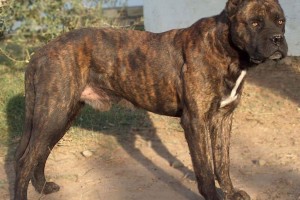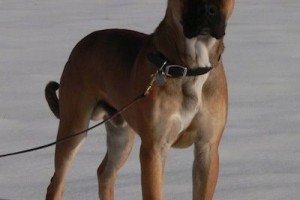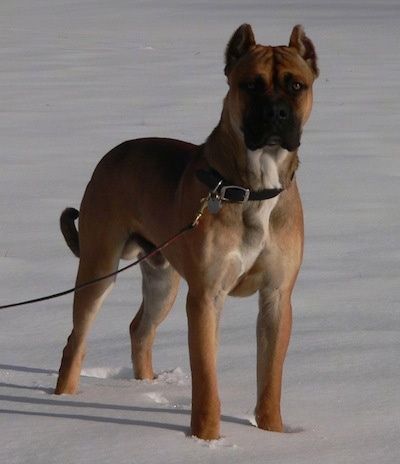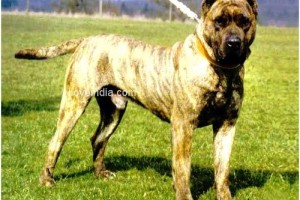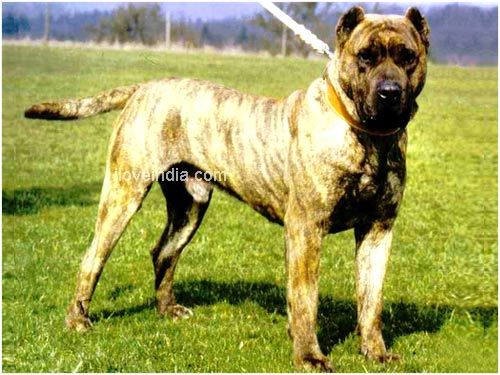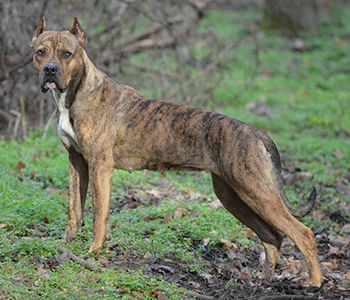Alano Espanol
 The Spanish Alano is a very old Molosser, believed to be one of the working breeds of the Alani tribe, which came to the Iberian Peninsula in the 5th century. Regarded by many as the direct descendant of the ancient Alaunt, this Spanish dog is also thought to be the ancestor of the Bullenbaisser dogs, as well as every other bull-type breed in the world. Some authorities view this breed as a living link between the Italian Cane Corso and the English Mastiff. It should be noted that while closely related to the Spanish Bulldog, the Alano is not the same breed, as some might think.
The Spanish Alano is a very old Molosser, believed to be one of the working breeds of the Alani tribe, which came to the Iberian Peninsula in the 5th century. Regarded by many as the direct descendant of the ancient Alaunt, this Spanish dog is also thought to be the ancestor of the Bullenbaisser dogs, as well as every other bull-type breed in the world. Some authorities view this breed as a living link between the Italian Cane Corso and the English Mastiff. It should be noted that while closely related to the Spanish Bulldog, the Alano is not the same breed, as some might think.
 Found in a variety of types in the past, the Spanish Dogge was eventually reduced to a single variant by the early 20th century. Due to the matings with the English Mastiff, German Boxer, American Staffordshire Terrier and other imported breeds, the glorious Chato Salmatino in its pure form was nearing extinction during the post-baiting sports era, but was fortunately saved through careful breeding of some 300 representatives of this breed discovered throughout Northern Spain in the 1980's. Further crossings with surviving Spanish Bulldogs and Villano Bulldogs helped re-establish the desired type, although many fanciers believe that no such outcrosses were used. Whatever the case may be, the revival/reconstruction of the Spanish Dogge has been a success and today, this is an increasingly popular Molosser, becoming more common outside its native borders.
Found in a variety of types in the past, the Spanish Dogge was eventually reduced to a single variant by the early 20th century. Due to the matings with the English Mastiff, German Boxer, American Staffordshire Terrier and other imported breeds, the glorious Chato Salmatino in its pure form was nearing extinction during the post-baiting sports era, but was fortunately saved through careful breeding of some 300 representatives of this breed discovered throughout Northern Spain in the 1980's. Further crossings with surviving Spanish Bulldogs and Villano Bulldogs helped re-establish the desired type, although many fanciers believe that no such outcrosses were used. Whatever the case may be, the revival/reconstruction of the Spanish Dogge has been a success and today, this is an increasingly popular Molosser, becoming more common outside its native borders.
However, with this popularity also came the emergence of some questionable strains, many of which are thought to have other breeds in their background, such as the Bullmastiff, Cane Corso, Presa Canario and similar dogges. Some rumours imply that a number of modern dogs presented as pure Alanos are nothing more than crosses between the almost extinct Spanish Bullterrier and a Boxer, but these claims haven't been proven and are generally dismissed by the majority of Alano Espanol enthusiasts. Dedicated breed fanciers are working diligently to ensure the Spanish Dogge's survival and are promoting health testing and breeding practices based on the dog's working abilities and not only physical appearance.

 A courageous working dog, the Alano excells as a boar-hunter, as well as a cattle controller. It also makes a fine property guardian, due to its territorial and protective nature. Fairly dog-aggressive, this breed requires proper socialization and responsible handling. The Spanish Alano is intuitive, intelligent and energetic, making a loving family dog, very affectionate with children and devoted to its owner. Broad-chested, well-muscled and superbly athletic, this is truly an impressive and powerful Moloss. The head is broad, with a reasonably short muzzle and strong jaws. The ears are usually cropped, although unaltered dogs are becoming more common. The short flat coat needs occasional brushing, making it an easy dog to take care of.
A courageous working dog, the Alano excells as a boar-hunter, as well as a cattle controller. It also makes a fine property guardian, due to its territorial and protective nature. Fairly dog-aggressive, this breed requires proper socialization and responsible handling. The Spanish Alano is intuitive, intelligent and energetic, making a loving family dog, very affectionate with children and devoted to its owner. Broad-chested, well-muscled and superbly athletic, this is truly an impressive and powerful Moloss. The head is broad, with a reasonably short muzzle and strong jaws. The ears are usually cropped, although unaltered dogs are becoming more common. The short flat coat needs occasional brushing, making it an easy dog to take care of.
Colours include red, yellow, fawn, wolf gray and various brindles, including a black-n-tan variety, sometimes with brindling over the tan parts. Lighter-coloured examples usually have black masks, but some unmasked dogs can be encountered as well. Small white markings are allowed, but aren't valued by some purists. The average height is around 25 inches, with slightly smaller dogs being preferred.
-
The Sarmathians, living in the flatlands in the Steppes from Central Asia, Ukrania and to the Caucasus, used to marry Assyrian Princess with their noble sons, in order to keep peace with the Assyrians, probably the Alaunt is the customized breed of dog adapted to long runs with the horsemen, of the heavier Assyrian Mastiff, because of the familiarity with them, the Yamnayas, whose lived in the Ucranian Steppes 3000 years before the current era, when invaded European territory, and Spain, carry with them the Shepherd Mastiffs, because of the domestic cattle they introduced with them in those lands. They taught the Iberians to handled cattle and ride horses, the new technics of the time, it´s only when the Alaunts arrive to Europe, that they brough their hunting dogs with them.
Recent DNA studies describe that in Spain most of the males of the neolitic were killed, and the Yamnayas tribes take all the womans in Spain for them, 8000 to 5000 years ago at least in the Bronce Era, and brough with them the ancestor of the Spanish Mastiff. But in those times they seem that did not brough with them heavy hounds for hunting with them, in roman mosaics, the Roman Molossus are well represented in Olmeda, Valencia Spain, and other toman mosaic era.
The Arabians in Spain, during the occupation, call to the alaunts the Germanic Dogs, in the bullfights when a new noble son of the arabian were born and make bullfights to celebrate.
Gasthon Phoebus Comte de Foix, circa 1380 aprox. mention on his books, that the bird dogs, and the Alaunts, were obtained from Spain, were not native from Spain.
The Spanish dictionary of the XIX century, mentions that the Alaunt was the cross between the Mastiff and the grayhound. Obviously there was not cinophilia and scientist studies in those times.
Cazalla, the best in show Alano, used to have foregingers in the legs, which is common in the Spanish Mastiff, and resemble the old German Boarhound with no Suliot dog or Irish Wolfhound blood on it.
Sarmatian coin
Exists a chariot of the Bronce Era in Spain of a man hunting a Boar, but is hard to explain if it is a Podenco, a light Mastiff or another dog, it belongs to Yamnaya culture, since the iberians start to use the horses and chariots until the arrival of the Yamnayas of the Steppes, 8000 years ago, putting end to the Neolitic era.
-
Ivan H Plauchu Thank you for sharing your knowledge and photos with us. It is great to have you here.
-
-

